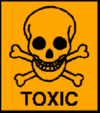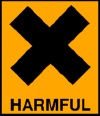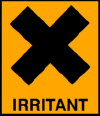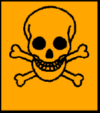Chemical Hazards
Chemical Hazards
Hazardous Substances
The initial part of a COSHH assessment involves identifying the chemical hazards that are present in the work activity you will be engaging in. The hazardous substances which are relevant to COSHH are those which may be corrosive, harmful, an irritant, toxic or a carcinogen. Note that materials which are hazardous because of their flammable nature, or that they can cause explosions, are relevant to general risk assessments (as are cryogens, where there is potential for burns and frostbite). Basic information on the chemical hazards that must be controlled following COSHH guidelines is found by following these links: Corrosive Hazards | Toxic and Harmful Materials | Carcinogens
Asbestos and lead have their on regulations and are not covered by COSHH.
Risk Phrases
The hazardous nature of the chemicals you intend to use can be determined by checking its risk phrase. This is usually in the form ‘Rn’ where ‘n’ is a number between 1 and 68 e.g. a chemical with the risk phrase R41 means that it may pose a risk of serious damage to eyes. Manufacturers of hazardous materials are obliged to provide risk phrases for their products as stated in the Chemicals (Hazard Information and Packaging for supply) or CHIP Regulations of 2002. More information on risk phrases can be found at the HSE CHIP site.
Materials Data Sheets
If you purchase a hazardous substance the supplier is required to provide you with a Material Data Sheet (MDS). The MDS is very useful as it will give you detailed information on the chemical hazards associated with the material you will be working with and it should offer advice on what risk controls should be adopted. You may obtain a MDS on certain commonly used chemicals from Fisher Scientific or you may obtain the risk phrases from Sigma-Aldrich.
New Materials
Some work activities involve the synthesis of new materials, other activities involve measurements being made on materials synthesized by other research groups. In both cases it is the responsibility of the person producing the substance to assess its hazards. Some new materials may be very similar to those already in existence and it may be possible to assume that they provide similar hazards. However, if nothing is known about a new material it should be treated as if it were highly hazardous.
Basic Information on Chemical Hazards
Corrosive Hazards Corrosives (liquids, solids, and gases) are chemicals that cause visible destruction of, or irreversible alterations in, living tissue by chemical action at the site of contact. Corrosive effects can occur not only to the skin and eyes, but also to the respiratory tract through inhalation and to the gastrointestinal tract through ingestion. Corrosive liquids have a high potential to cause external injury to the body, while corrosive gases are readily absorbed into the body through skin contact and inhalation. Corrosive solids and their dusts can damage tissue by dissolving rapidly in moisture on the skin or within the respiratory tract when inhaled.Specific corrosive chemicals include strong acids and bases, dehydrating agents, non-metal chlorides, halogens and other compounds that hydrolise to acids. Back to top Corrosives (liquids, solids, and gases) are chemicals that cause visible destruction of, or irreversible alterations in, living tissue by chemical action at the site of contact. Corrosive effects can occur not only to the skin and eyes, but also to the respiratory tract through inhalation and to the gastrointestinal tract through ingestion. Corrosive liquids have a high potential to cause external injury to the body, while corrosive gases are readily absorbed into the body through skin contact and inhalation. Corrosive solids and their dusts can damage tissue by dissolving rapidly in moisture on the skin or within the respiratory tract when inhaled.Specific corrosive chemicals include strong acids and bases, dehydrating agents, non-metal chlorides, halogens and other compounds that hydrolise to acids. Back to top |
Toxic and Harmful Materials    Entry or Exposure Routes Major routes of exposure are through the skin, through the lung (inhalation) or through the gastrointestinal tract (ingestion). In general, inhalation is likely to cause more damage than ingestion, which, in turn, is more harmful than skin exposure. Skin Absorption.This is the least likely route of penetration since the natural thickness of the skin plus its natural coating of grease and sweat provide some protection against chemicals. However, some materials are capable of penetrating intact, healthy skin e.g. aniline, hydrogen cyanide, some steroid hormones, organic mercury compounds, nitrobenzene, organophosphate compounds and phenol. Phenol itself can be lethal if absorbed for a sufficient time through a few square cm of skin and inappropriate protective clothing e.g. incorrect gloves may cause absorption rate to increase.The natural protection of the skin may also be bypassed through cuts, abrasion or puncture wounds e.g. needle-stick injury. Inhalation.Gases and vapours, aerosols and fumes are readily inhaled and may cause harm (including asphyxiation) anywhere in the respiratory system and may also be absorbed into the bloodstream but inhalation of particles depends upon their size and shape -the smaller the particle, the further into the respiratory tract it can go.Large particles are filtered off in the nose.Smaller particles, or those breathed in by mouth, settle on the walls of the upper respiratory tract or throat and are coughed up and either ejected or swallowed. If swallowed, they may enter the gut and cause damage as if they had been ingested.The smallest particles of dust and fibres can be inhaled down into the lungs where they can cause local damage, sometimes by interaction with the cells in the lungs which normally remove bacteria. These particles may also be absorbed into the bloodstream. Ingestion.Airborne particles that are eventually swallowed are the most likely source of ingested chemical. Otherwise, ingestion of potentially toxic substances is likely to be accidental on contaminated food or drink. Once absorbed through the stomach or intestine, the route to excretion may be complex and damaging. Adverse Effects Adverse Effects may be local or systemic.Local Effects occur at the site of exposure e.g. corrosives and often irritants.Systemic Effects occur at a target organ or at site remote from the point of contact following absorption and distribution around the body.Some substances produce both effects e.g. lead tetraethyl damages the skin on contact and is the absorbed and transported to the central nervous system where it may cause further damage. Adverse Effects may also be acute or chronic.Acute Effects are immediate such as the effect from inhaling chlorine.Chronic Effects are much slower, often cumulative following repeated exposures. Chronic effects can be the most difficult to avoid because damage may not become evident for many years. Adverse Effects may also be reversible or irreversible.Reversible Effects: damage can be repaired by the body’s natural processes.Irreversible Effects: cannot be repaired e.g. dead nerve cells cannot be replaced. Adverse Effects may be psychological as well as purely physical. Response of the Body IrritationRespiratory: Chemicals can irritate the nose and upper respiratory tract causing sneezing, coughing and, in some cases, bronchitis. They may also damage lung tissue.Skin and Eyes: Chemicals on skin often cause dermatitis (a rash). Solvents can de-grease the skin causing it to become red and sore. Corrosive material such as strong acids and bases can be irritants in dilute form but cause severe burns when concentrated. Eyes are particularly vulnerable and damage can be permanent. SensitisationRespiratory: Some chemicals can cause sensitisation leading to asthma. Once sensitised, even minimal exposure can cause a severe allergic response.Skin: Sensitisation can occur through contact with a chemical and the skin. As before, once sensitised, minimal contact can cause an allergic response causing severe itching and other discomfort. Long-term EffectsThe most serious of long-term effects is cancer, a disorder of cell growth. Here the effect of exposure may not be evident for many years. Carcinogenic materials are considered in more detail below. Reproductive DisordersPossible effects are loss of fertility in both men and women, heritable genetic damage or harm to the unborn child. Back to top Entry or Exposure Routes Major routes of exposure are through the skin, through the lung (inhalation) or through the gastrointestinal tract (ingestion). In general, inhalation is likely to cause more damage than ingestion, which, in turn, is more harmful than skin exposure. Skin Absorption.This is the least likely route of penetration since the natural thickness of the skin plus its natural coating of grease and sweat provide some protection against chemicals. However, some materials are capable of penetrating intact, healthy skin e.g. aniline, hydrogen cyanide, some steroid hormones, organic mercury compounds, nitrobenzene, organophosphate compounds and phenol. Phenol itself can be lethal if absorbed for a sufficient time through a few square cm of skin and inappropriate protective clothing e.g. incorrect gloves may cause absorption rate to increase.The natural protection of the skin may also be bypassed through cuts, abrasion or puncture wounds e.g. needle-stick injury. Inhalation.Gases and vapours, aerosols and fumes are readily inhaled and may cause harm (including asphyxiation) anywhere in the respiratory system and may also be absorbed into the bloodstream but inhalation of particles depends upon their size and shape -the smaller the particle, the further into the respiratory tract it can go.Large particles are filtered off in the nose.Smaller particles, or those breathed in by mouth, settle on the walls of the upper respiratory tract or throat and are coughed up and either ejected or swallowed. If swallowed, they may enter the gut and cause damage as if they had been ingested.The smallest particles of dust and fibres can be inhaled down into the lungs where they can cause local damage, sometimes by interaction with the cells in the lungs which normally remove bacteria. These particles may also be absorbed into the bloodstream. Ingestion.Airborne particles that are eventually swallowed are the most likely source of ingested chemical. Otherwise, ingestion of potentially toxic substances is likely to be accidental on contaminated food or drink. Once absorbed through the stomach or intestine, the route to excretion may be complex and damaging. Adverse Effects Adverse Effects may be local or systemic.Local Effects occur at the site of exposure e.g. corrosives and often irritants.Systemic Effects occur at a target organ or at site remote from the point of contact following absorption and distribution around the body.Some substances produce both effects e.g. lead tetraethyl damages the skin on contact and is the absorbed and transported to the central nervous system where it may cause further damage. Adverse Effects may also be acute or chronic.Acute Effects are immediate such as the effect from inhaling chlorine.Chronic Effects are much slower, often cumulative following repeated exposures. Chronic effects can be the most difficult to avoid because damage may not become evident for many years. Adverse Effects may also be reversible or irreversible.Reversible Effects: damage can be repaired by the body’s natural processes.Irreversible Effects: cannot be repaired e.g. dead nerve cells cannot be replaced. Adverse Effects may be psychological as well as purely physical. Response of the Body IrritationRespiratory: Chemicals can irritate the nose and upper respiratory tract causing sneezing, coughing and, in some cases, bronchitis. They may also damage lung tissue.Skin and Eyes: Chemicals on skin often cause dermatitis (a rash). Solvents can de-grease the skin causing it to become red and sore. Corrosive material such as strong acids and bases can be irritants in dilute form but cause severe burns when concentrated. Eyes are particularly vulnerable and damage can be permanent. SensitisationRespiratory: Some chemicals can cause sensitisation leading to asthma. Once sensitised, even minimal exposure can cause a severe allergic response.Skin: Sensitisation can occur through contact with a chemical and the skin. As before, once sensitised, minimal contact can cause an allergic response causing severe itching and other discomfort. Long-term EffectsThe most serious of long-term effects is cancer, a disorder of cell growth. Here the effect of exposure may not be evident for many years. Carcinogenic materials are considered in more detail below. Reproductive DisordersPossible effects are loss of fertility in both men and women, heritable genetic damage or harm to the unborn child. Back to top |
Carcinogens   Cancer may arise from various causes, one of which is the adverse effects of certain substances on the cells of the body. Under the UK Control of Substances Hazardous to Health Regulations, a carcinogen is defined as: ● Any substance or preparation which if classified under the CHIP Regulations, would be required to be labelled with the Risk Phrases R45 “may cause cancer” or R49 “may cause cancer by inhalation”. CHIP itself divides carcinogens into three categories: Category 1 – substances known to be carcinogenic to humans. There is sufficient evidence to establish a causal association between human exposure to the substance and the development of cancer.Category 2 – substances that should be regarded as if they are carcinogenic to humans, for which there is sufficient evidence, based on long-term animal studies and other relevant information, to provide a strong presumption that human exposure may result in the development of cancer.Category 3 – substances that cause concern owing to possible carcinogenic effects but for which available information is not adequate to make satisfactory assessments.Categories 1 and 2, if purchased from a supplier will carry the “toxic” (T) symbol and the Risk Phrase R45 (may cause cancer) or R49 (may cause cancer by inhalation).Category 3, if purchased from a supplier carries the “harmful” (Xn) symbol and the Risk Phrase R40 (limited evidence of carcinogenic effect). MutagensNote that some substances are mutagens and can cause heritable genetic changes (mutations). Most mutations are harmful and most mutagens are carcinogens and vice versa.Substances that are known to impair fertility or to cause developmental toxicity in humans are defined as toxic to reproduction. (Note that tetragens are substances that adversely affect the developing foetus).Because of the danger to fertility, women of child-bearing age are especially advised to avoid working with substances which are carcinogens, mutagens or substances toxic to reproduction.Mutagens and Substances Toxic to Reproduction similarly are classified in Categories 1 to 3. Category 1 and 2 mutagens carry the Risk Phrase R46 “May cause heritable genetic damage” and substances toxic to reproduction carry the Phrase R60 “May impair fertility” or R61 “May cause harm to the unborn child“. Category 3 mutagens have the Risk Phrase ” Possible risk of irreversible effects“ and Category 3 substances toxic to reproduction are classified by R62 “Possible risk of impaired fertility” or R63 “Possible risk of harm to the unborn child“. Back to top Cancer may arise from various causes, one of which is the adverse effects of certain substances on the cells of the body. Under the UK Control of Substances Hazardous to Health Regulations, a carcinogen is defined as: ● Any substance or preparation which if classified under the CHIP Regulations, would be required to be labelled with the Risk Phrases R45 “may cause cancer” or R49 “may cause cancer by inhalation”. CHIP itself divides carcinogens into three categories: Category 1 – substances known to be carcinogenic to humans. There is sufficient evidence to establish a causal association between human exposure to the substance and the development of cancer.Category 2 – substances that should be regarded as if they are carcinogenic to humans, for which there is sufficient evidence, based on long-term animal studies and other relevant information, to provide a strong presumption that human exposure may result in the development of cancer.Category 3 – substances that cause concern owing to possible carcinogenic effects but for which available information is not adequate to make satisfactory assessments.Categories 1 and 2, if purchased from a supplier will carry the “toxic” (T) symbol and the Risk Phrase R45 (may cause cancer) or R49 (may cause cancer by inhalation).Category 3, if purchased from a supplier carries the “harmful” (Xn) symbol and the Risk Phrase R40 (limited evidence of carcinogenic effect). MutagensNote that some substances are mutagens and can cause heritable genetic changes (mutations). Most mutations are harmful and most mutagens are carcinogens and vice versa.Substances that are known to impair fertility or to cause developmental toxicity in humans are defined as toxic to reproduction. (Note that tetragens are substances that adversely affect the developing foetus).Because of the danger to fertility, women of child-bearing age are especially advised to avoid working with substances which are carcinogens, mutagens or substances toxic to reproduction.Mutagens and Substances Toxic to Reproduction similarly are classified in Categories 1 to 3. Category 1 and 2 mutagens carry the Risk Phrase R46 “May cause heritable genetic damage” and substances toxic to reproduction carry the Phrase R60 “May impair fertility” or R61 “May cause harm to the unborn child“. Category 3 mutagens have the Risk Phrase ” Possible risk of irreversible effects“ and Category 3 substances toxic to reproduction are classified by R62 “Possible risk of impaired fertility” or R63 “Possible risk of harm to the unborn child“. Back to top |
